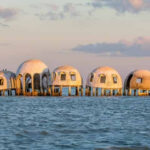The mesmerizing dance of the Northern Lights, or Aurora Borealis, is a spectacle that tops many travel bucket lists. A frequent question for aurora enthusiasts is: Where Can You See The Northern Lights? The answer is intricately linked to solar activity, specifically the sun’s 11-year solar cycle.
Understanding the Solar Cycle and its Aurora Connection
The sun’s magnetic field undergoes a cyclical transformation approximately every 11 years. This cycle is marked by changes in sunspot numbers, dark spots on the sun’s surface indicating magnetic activity. Solar Minimum signifies the cycle’s start and end, characterized by fewer sunspots. Conversely, Solar Maximum, the cycle’s midpoint, boasts the highest sunspot count and heightened solar activity.
Alt text: Vibrant green and purple Northern Lights illuminate the night sky above a snow-covered landscape with distant mountains, showcasing a typical aurora viewing location.
This solar cycle is crucial because increased solar activity, particularly solar flares and coronal mass ejections, directly influences aurora visibility. During Solar Maximum, these events are more frequent, generally leading to more intense and frequent aurora displays. Therefore, Solar Maximum is often considered the prime time for witnessing the Northern Lights.
Aurora Visibility Throughout the Solar Cycle
However, it’s a common misconception that auroras are exclusive to Solar Maximum. Even during the quieter periods of Solar Minimum, the sun continuously emits solar wind. Moreover, coronal holes, which can be long-lived during solar minimum, are also sources of solar wind that trigger auroras. This means the Northern Lights are visible throughout the entire 11-year solar cycle.
Instead of solely focusing on the solar cycle phase, consider other crucial factors. Weather conditions, especially cloud cover, play a significant role. To maximize your chances, aim for clear nights within the auroral oval, the region around the Earth’s magnetic poles where auroras are most frequently seen. The months between September and April generally offer optimal viewing conditions due to longer periods of darkness in these high-latitude regions.
Prime Locations for Northern Lights Viewing
So, where can you see the northern lights most reliably? The auroral oval passes over several countries in the Northern Hemisphere, making them ideal destinations:
- Alaska (USA): Renowned for its dark skies and vast wilderness.
- Canada: Especially the Yukon, Northwest Territories, and Nunavut.
- Iceland: Easily accessible and offers stunning landscapes with aurora displays.
- Norway: Particularly Northern Norway, including the Lofoten Islands and Tromsø.
- Sweden: Swedish Lapland is a popular aurora viewing destination.
- Finland: Finnish Lapland provides a magical winter wonderland setting.
- Greenland: Offers remote and pristine aurora viewing opportunities.
Solar Cycle 25: Current Excitement
There’s considerable excitement surrounding the current Solar Cycle #25, which began in 2020. Many scientists predict it could be exceptionally strong, and recent aurora displays in 2023 and 2024 have indeed been remarkably vibrant. While this heightened activity is thrilling, remember that impressive auroras are possible even outside peak solar activity periods.
In conclusion, while the solar cycle influences aurora frequency and intensity, it doesn’t dictate whether you can see them. The Northern Lights are a year-round phenomenon. Focus on being in the right location – within the auroral oval during the dark winter months – and checking aurora forecasts for the best chance to witness nature’s spectacular light show, regardless of the solar cycle phase.


